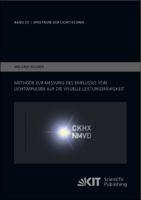Methode zur Messung des Einflusses von Lichtimpulsen auf die visuelle Leistungsfähigkeit
Dissertations in Series (Dissertationen in Schriftenreihe)
| dc.contributor.author | Helmer, Melanie | |
| dc.date.accessioned | 2021-06-10T11:24:21Z | |
| dc.date.available | 2021-06-10T11:24:21Z | |
| dc.date.issued | 2021 | |
| dc.identifier | ONIX_20210610_9783731510130_5 | |
| dc.identifier | ONIX_20210610_9783731510130_5 | |
| dc.identifier | OCN: 1262674663 | |
| dc.identifier.issn | 2195-1152 | |
| dc.identifier.uri | https://library.oapen.org/handle/20.500.12657/49459 | |
| dc.language | German | |
| dc.relation.ispartofseries | Spektrum der Lichttechnik | |
| dc.subject.classification | thema EDItEUR::T Technology, Engineering, Agriculture, Industrial processes::TH Energy technology and engineering::THR Electrical engineering | en_US |
| dc.subject.other | Blendung | |
| dc.subject.other | Adaptation | |
| dc.subject.other | Licht | |
| dc.subject.other | Visuelle Wahrnehmung | |
| dc.subject.other | Kurzzeitgedächtnis | |
| dc.subject.other | Glare | |
| dc.subject.other | Adaption | |
| dc.subject.other | Light | |
| dc.subject.other | VisualPperception | |
| dc.subject.other | Short Time Memory | |
| dc.title | Methode zur Messung des Einflusses von Lichtimpulsen auf die visuelle Leistungsfähigkeit | |
| dc.type | book | |
| oapen.abstract.otherlanguage | Due to its dynamic range, the human eye can adapt to a wide variety of light situations within a very short time. If the dynamic range of the eye is insufficient, glare occurs. There is no suitable objective measurement method to describe the effects on visual performance and its course. This was developed and validated as part of this work. | |
| oapen.identifier.doi | 10.5445/KSP/1000105600 | |
| oapen.relation.isPublishedBy | 44e29711-8d53-496b-85cc-3d10c9469be9 | |
| oapen.relation.isbn | 9783731510130 | |
| oapen.collection | AG Universitätsverlage | |
| oapen.imprint | KIT Scientific Publishing | |
| oapen.series.number | 24 | |
| oapen.pages | 248 | |
| oapen.place.publication | Karlsruhe | |
| peerreview.anonymity | All identities known | |
| peerreview.id | 51a542ec-eaeb-47c2-861d-6022e981a97a | |
| peerreview.open.review | No | |
| peerreview.publish.responsibility | Books or series editor | |
| peerreview.review.stage | Pre-publication | |
| peerreview.review.type | Full text | |
| peerreview.reviewer.type | Editorial board member | |
| peerreview.reviewer.type | External peer reviewer | |
| peerreview.title | Dissertations in Series (Dissertationen in Schriftenreihe) |

